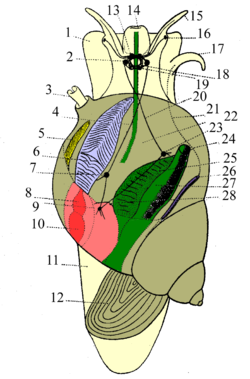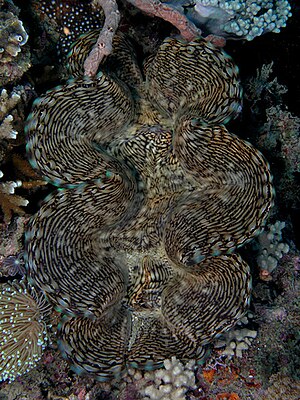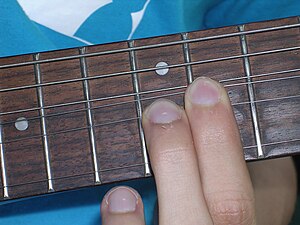Difference between revisions of "AY Honors/Shells/Answer Key"
| Line 84: | Line 84: | ||
;Fret board markers: The markers (often round dots) between the frets on the fingerboard of a guitar (or other stringed instrument) are made of shell. | ;Fret board markers: The markers (often round dots) between the frets on the fingerboard of a guitar (or other stringed instrument) are made of shell. | ||
;Utensils: Shells were used to make spoons, knives, cups, and dishes by primative cultures. | ;Utensils: Shells were used to make spoons, knives, cups, and dishes by primative cultures. | ||
| − | ;Chemistry: Shells are made from calcium carbonate, a chemical useful in the laboratory. Calcium carbonate is widely used medicinally as an inexpensive dietary calcium supplement or antacid. | + | ;Chemistry: Shells are made from calcium carbonate, a chemical useful in the laboratory. Calcium carbonate is widely used medicinally as an inexpensive dietary calcium supplement or antacid. It is also used in the pharmaceutical industry as a base material for tablets of other pharmaceuticals. |
| − | It is also used in the pharmaceutical industry as a base material for tablets of other pharmaceuticals. | ||
;Lime: Seashells can be crushed to make lime which is used to raise the pH level in soil. | ;Lime: Seashells can be crushed to make lime which is used to raise the pH level in soil. | ||
<br style="clear:both"> | <br style="clear:both"> | ||
Revision as of 02:33, 8 December 2007
1. What is the meaning of the term "mollusk"?
Mollusk is another name for shellfish. A mollusk is a soft-bodied invertebrate of the phylum Mollusca, typically with a hard shell of one or more pieces. The word "mollusk" comes from the Latin meaning "soft, flexible, tender" referring to the mollusk's soft body parts.
2. Identify from shells or drawings the following:
We present here a diagram that features many, many more details of a mollusk's anatomy than are called out in this requirement. See the features depicted in bold text are required - the rest are just additional information.
| 1. foot 2. pleural ganglion |
15. tentacle 16. eye |
- a. Mantle
- The mantle is an organ covering the soft parts of a mollusk. It secrets calcium carbonate to create the shell.
- b. Foot
- The foot is the largest visible portion of a mollusk other than the shell. It is the soft part that protrudes from the shell and touches the surface of whatever the mollusk is crawling on.
- c. Teeth
- The "teeth" of a mollosk are called radula by scientists. They are more like a jagged tongue than they are like teeth (see the diagram on the right). Mollusks use them to chew food and to scrape algae from rocks.
- d. Ribs
- Ribs are any raised ridges on the surface of a shell.
- e. Valve
- A valve is half the shell of a mollusk with a two-part shell. The two valves are joined by a hinge. These mollusks are called bivalves, and include clams (left), oysters, and mussels.
- f. Dorsal border
- The dorsal border is the edge of a bivalve's shell where the hinge is located.
- g. Apex
- The apex is the tip or point of the shell. It is not labeled in our diagram, though it is clearly visible (lower right).
- h. Operculum
- The operculum is a hard structure situated at the end of the foot, and is used to seal off the entry to the shell. You can think of it as a combination shoe/door.
- i. Canal
- Many marine gastropods are burrowers, and have soft siphons or tubes that extend from the mantle. Sometimes the shell has a siphonal canal to accommodate this structure. These siphons act as snorkels, enabling the animal to continue to draw in a water current containing oxygen and food into their bodies. The siphons are also used to "taste" the water, in order to detect prey from a distance.
3. Are all shells found on beaches? Where else are they found? What areas of the world offer the largest variety of shells?
Shells are found in many places other than the beach, including river banks, river bottoms, lake shores, lake bottoms, and the seafloor. They are also found on land, as snails belong to the mollusk phylum.
The Caribbean and the Western Pacific are home to the largest variety of shells.
4. Describe the movement of shells from place to place.
Mollusks have several methods of getting around, depending on the species. Some have tiny hair-like structures on the foot called cilia which they use to propel themselves through a slimy substance they secrete. Others generate waves of motion along the length of the foot. Still others pump water through their shells and let the resulting jet push them forward.
Mollusks can also be moved by water currents.
5. How do shell animals protect themselves?
Mollusks pull the soft portion of their bodies into their shells and seal the entry with their operculum. They can also burrow below the surface of the sea-, river-, or lake-bottom.
6. How are shells made and from what materials are they made?
Shells are formed when the animal secretes calcium carbonate from the mantel. The calcium carbonate hardens into a shell. The apex of the shell is formed first, and as the animal grows, more is added to the shell at the opening.
7. List and explain five uses made of shells by man.
Shells have been used by man in the following ways:
- Money
- Shells have been used in many cultures as a form of money.
- Buttons
- Buttons were originally cut from shells. Plastic buttons we use today still resembled the pearly surface of the inside of a seashell.
- Adornment
- Many cultures made (and make) jewelry from shells. Holes can be drilled into shells to make beads. Shells are also inlaid into wood in an artform called intarsia (also in marquetry and parquetry).
- Hair combs
- Shells have been cut to shape and used to comb hair.
- Fret board markers
- The markers (often round dots) between the frets on the fingerboard of a guitar (or other stringed instrument) are made of shell.
- Utensils
- Shells were used to make spoons, knives, cups, and dishes by primative cultures.
- Chemistry
- Shells are made from calcium carbonate, a chemical useful in the laboratory. Calcium carbonate is widely used medicinally as an inexpensive dietary calcium supplement or antacid. It is also used in the pharmaceutical industry as a base material for tablets of other pharmaceuticals.
- Lime
- Seashells can be crushed to make lime which is used to raise the pH level in soil.
8. Explain the terms "univalve" and "bivalve" as applied to shells.
9. Name in common terms five different classes of shells and name in your collection a shell for each class.
10. Make a collection of 20 different shells, classify them, and tell where each is found and when it came into your possession.
11. What is the source of pearls? What spiritual lessons does the pearl teach us? Read and discuss Christ's Object Lessons by Ellen G. White, pages 115 to 118.
12. Match the Bible texts that best answers A-J:
| Leviticus 11:9,10 | a. Water creatures were created on what day? |
| Acts 16:14 | b. The number of water creatures is innumerable. |
| Isaiah 50:2 | c. Water creatures perish out of water. |
| Revelation 21:21 | d. Job considered coral of great value. |
| 1 Timothy 2:9 | e. Solomon was acquainted with marine life. |
| Genesis 1:20, 21 | f. Jesus twice used a shell product to teach a spiritual lesson. |
| 1 Kings 4:33 | g. A businesswoman was engaged in selling the famous purple dyes secured from the shellfish Mediterranean Murex. |
| Psalms 104:25 | h. Paul does not support the wearing of pearls. |
| Matthew 7:6; 13:45,46 | i. Shell creatures are unfit for food. |
| Job 28:18 | j. The twelve gates of Holy City are twelve pearls. |
All scriputre passages below are from the New International Version.
- a. Water creatures were created on what day?
- And God said, "Let the water teem with living creatures, and let birds fly above the earth across the expanse of the sky." So God created the great creatures of the sea and every living and moving thing with which the water teems, according to their kinds, and every winged bird according to its kind. And God saw that it was good. Genesis 1:20, 21 NIV
- b. The number of water creatures is innumerable.
- There is the sea, vast and spacious,
- teeming with creatures beyond number—
- living things both large and small. Psalms 104:25
- c. Water creatures perish out of water.
- When I came, why was there no one?
- When I called, why was there no one to answer?
- Was my arm too short to ransom you?
- Do I lack the strength to rescue you?
- By a mere rebuke I dry up the sea,
- I turn rivers into a desert;
- their fish rot for lack of water
- and die of thirst. Isaiah 50:2
- d. Job considered coral of great value.
- Coral and jasper are not worthy of mention; the price of wisdom is beyond rubies. Job 28:18
- e. Solomon was acquainted with marine life.
- He described plant life, from the cedar of Lebanon to the hyssop that grows out of walls. He also taught about animals and birds, reptiles and fish. 1 Kings 4:33
- f. Jesus twice used a shell product to teach a spiritual lesson.
- "Do not give dogs what is sacred; do not throw your pearls to pigs. If you do, they may trample them under their feet, and then turn and tear you to pieces. Matthew 7:6
- "Again, the kingdom of heaven is like a merchant looking for fine pearls. When he found one of great value, he went away and sold everything he had and bought it. Matthew 13:45,46
- g. A businesswoman was engaged in selling the famous purple dyes secured from the shellfish Mediterranean Murex.
- One of those listening was a woman named Lydia, a dealer in purple cloth from the city of Thyatira, who was a worshiper of God. The Lord opened her heart to respond to Paul's message. Acts 16:14
- h. Paul does not support the wearing of pearl
- I also want women to dress modestly, with decency and propriety, not with braided hair or gold or pearls or expensive clothes. 1 Timothy 2:9
- i. Shell creatures are unfit for food.
- " 'Of all the creatures living in the water of the seas and the streams, you may eat any that have fins and scales. But all creatures in the seas or streams that do not have fins and scales—whether among all the swarming things or among all the other living creatures in the water—you are to detest. Leviticus 11:9,10
- j. The twelve gates of Holy City are twelve pearls.
- The twelve gates were twelve pearls, each gate made of a single pearl. The great street of the city was of pure gold, like transparent glass. Revelation 21:21




